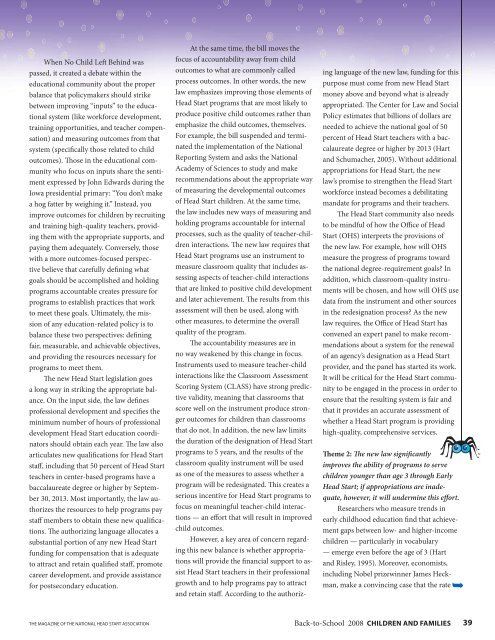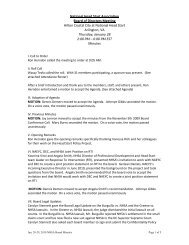New! - National Head Start Association
New! - National Head Start Association
New! - National Head Start Association
You also want an ePaper? Increase the reach of your titles
YUMPU automatically turns print PDFs into web optimized ePapers that Google loves.
When No Child Le Behind was<br />
passed, it created a debate within the<br />
educational community about the proper<br />
balance that policymakers should strike<br />
between improving “inputs” to the educational<br />
system (like workforce development,<br />
training opportunities, and teacher compensation)<br />
and measuring outcomes from that<br />
system (speci cally those related to child<br />
outcomes). ose in the educational community<br />
who focus on inputs share the sentiment<br />
expressed by John Edwards during the<br />
Iowa presidential primary: “You don’t make<br />
a hog fatter by weighing it.” Instead, you<br />
improve outcomes for children by recruiting<br />
and training high-quality teachers, providing<br />
them with the appropriate supports, and<br />
paying them adequately. Conversely, those<br />
with a more outcomes-focused perspective<br />
believe that carefully de ning what<br />
goals should be accomplished and holding<br />
programs accountable creates pressure for<br />
programs to establish practices that work<br />
to meet these goals. Ultimately, the mission<br />
of any education-related policy is to<br />
balance these two perspectives: de ning<br />
fair, measurable, and achievable objectives,<br />
and providing the resources necessary for<br />
programs to meet them.<br />
e new <strong>Head</strong> <strong>Start</strong> legislation goes<br />
a long way in striking the appropriate balance.<br />
On the input side, the law de nes<br />
professional development and speci es the<br />
minimum number of hours of professional<br />
development <strong>Head</strong> <strong>Start</strong> education coordinators<br />
should obtain each year. e law also<br />
articulates new quali cations for <strong>Head</strong> <strong>Start</strong><br />
sta , including that 50 percent of <strong>Head</strong> <strong>Start</strong><br />
teachers in center-based programs have a<br />
baccalaureate degree or higher by September<br />
30, 2013. Most importantly, the law authorizes<br />
the resources to help programs pay<br />
sta members to obtain these new quali cations.<br />
e authorizing language allocates a<br />
substantial portion of any new <strong>Head</strong> <strong>Start</strong><br />
funding for compensation that is adequate<br />
to attract and retain quali ed sta , promote<br />
career development, and provide assistance<br />
for postsecondary education.<br />
At the same time, the bill moves the<br />
focus of accountability away from child<br />
outcomes to what are commonly called<br />
process outcomes. In other words, the new<br />
law emphasizes improving those elements of<br />
<strong>Head</strong> <strong>Start</strong> programs that are most likely to<br />
produce positive child outcomes rather than<br />
emphasize the child outcomes, themselves.<br />
For example, the bill suspended and terminated<br />
the implementation of the <strong>National</strong><br />
Reporting System and asks the <strong>National</strong><br />
Academy of Sciences to study and make<br />
recommendations about the appropriate way<br />
of measuring the developmental outcomes<br />
of <strong>Head</strong> <strong>Start</strong> children. At the same time,<br />
the law includes new ways of measuring and<br />
holding programs accountable for internal<br />
processes, such as the quality of teacher-children<br />
interactions. e new law requires that<br />
<strong>Head</strong> <strong>Start</strong> programs use an instrument to<br />
measure classroom quality that includes assessing<br />
aspects of teacher-child interactions<br />
that are linked to positive child development<br />
and later achievement. e results from this<br />
assessment will then be used, along with<br />
other measures, to determine the overall<br />
quality of the program.<br />
e accountability measures are in<br />
no way weakened by this change in focus.<br />
Instruments used to measure teacher-child<br />
interactions like the Classroom Assessment<br />
Scoring System (CLASS) have strong predictive<br />
validity, meaning that classrooms that<br />
score well on the instrument produce stronger<br />
outcomes for children than classrooms<br />
that do not. In addition, the new law limits<br />
the duration of the designation of <strong>Head</strong> <strong>Start</strong><br />
programs to 5 years, and the results of the<br />
classroom quality instrument will be used<br />
as one of the measures to assess whether a<br />
program will be redesignated. is creates a<br />
serious incentive for <strong>Head</strong> <strong>Start</strong> programs to<br />
focus on meaningful teacher-child interactions<br />
— an e ort that will result in improved<br />
child outcomes.<br />
However, a key area of concern regarding<br />
this new balance is whether appropriations<br />
will provide the nancial support to assist<br />
<strong>Head</strong> <strong>Start</strong> teachers in their professional<br />
growth and to help programs pay to attract<br />
and retain sta . According to the authoriz-<br />
ing language of the new law, funding for this<br />
purpose must come from new <strong>Head</strong> <strong>Start</strong><br />
money above and beyond what is already<br />
appropriated. e Center for Law and Social<br />
Policy estimates that billions of dollars are<br />
needed to achieve the national goal of 50<br />
percent of <strong>Head</strong> <strong>Start</strong> teachers with a baccalaureate<br />
degree or higher by 2013 (Hart<br />
and Schumacher, 2005). Without additional<br />
appropriations for <strong>Head</strong> <strong>Start</strong>, the new<br />
law’s promise to strengthen the <strong>Head</strong> <strong>Start</strong><br />
workforce instead becomes a debilitating<br />
mandate for programs and their teachers.<br />
e <strong>Head</strong> <strong>Start</strong> community also needs<br />
to be mindful of how the O ce of <strong>Head</strong><br />
<strong>Start</strong> (OHS) interprets the provisions of<br />
the new law. For example, how will OHS<br />
measure the progress of programs toward<br />
the national degree-requirement goals? In<br />
addition, which classroom-quality instruments<br />
will be chosen, and how will OHS use<br />
data from the instrument and other sources<br />
in the redesignation process? As the new<br />
law requires, the O ce of <strong>Head</strong> <strong>Start</strong> has<br />
convened an expert panel to make recommendations<br />
about a system for the renewal<br />
of an agency’s designation as a <strong>Head</strong> <strong>Start</strong><br />
provider, and the panel has started its work.<br />
It will be critical for the <strong>Head</strong> <strong>Start</strong> community<br />
to be engaged in the process in order to<br />
ensure that the resulting system is fair and<br />
that it provides an accurate assessment of<br />
whether a <strong>Head</strong> <strong>Start</strong> program is providing<br />
high-quality, comprehensive services.<br />
eme 2: e new law signi cantly<br />
improves the ability of programs to serve<br />
children younger than age 3 through Early<br />
<strong>Head</strong> <strong>Start</strong>; if appropriations are inadequate,<br />
however, it will undermine this e ort.<br />
Researchers who measure trends in<br />
early childhood education nd that achievement<br />
gaps between low- and higher-income<br />
children — particularly in vocabulary<br />
— emerge even before the age of 3 (Hart<br />
and Risley, 1995). Moreover, economists,<br />
including Nobel prizewinner James Heckman,<br />
make a convincing case that the rate<br />
THE MAGAZINE OF THE NATIONAL HEAD START ASSOCIATION Back-to-School 2008 CHILDREN AND FAMILIES 39




